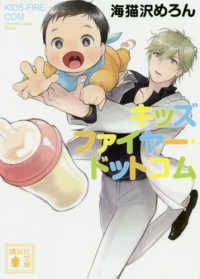Full Description
What are the behaviors or actions that teachers take to create high quality original curricula and programs for their students? The authors have searched out the most creative and adventurous teachers they could find and have weaved their real-life stories into the text. The text shows how teachers can inspire their students while still meeting the federal, state, and local guidelines and testing standards required in today's classrooms. Chapter One begins with a new, updated Reflected Action in Teaching Model designed for teachers who are planning with standards in mind. Each chapter then begins with a new case of how a teacher has tackled a problem in this standards-based environment applying this model. Both hands-on and practical, the text also addresses how to incorporate technology in the classroom, empowering students to resolve conflicts, and preventing bullying. In this sixth edition of Teaching in the Elementary School the reflective action model is explained and illustrated through new and expanded engaging case studies and classroom examples that illustrate how chapter concepts can be applied to the classroom. Readers will also find valuable coverage of differentiated instruction and collaboration. In addition, beginning teachers will find practical rubrics to help assess their continuing growth in such areas as classroom management, clarity and pacing of instruction, use of voice and body language, and much more!The real-life examples will encourage new teachers to be as reflective, creative, and independent as possible in today's teaching world.
Contents
Chapter OneReflective Action in Teaching Questions for reflection as you read the chapterA View into the ClassroomReflecting on the Classroom ExperienceTHE REFLECTIVE ACTION MODELDefinitions of Reflective Thinking and Action The Reflective PractitionerHow to Develop as a Reflective PractitionerDefining Withitness Reflective Action as It Relates to Withitness How to Improve Your WithitnessThe Spiral Curriculum The Art of TeachingThe Planning ProcessNational Teaching StandardsProfessional Organizations and Ethical StandardsEthical CaringINVOLVING THE LARGER EDUCATIONAL COMMUNITYGROUP FOCUS ACTIVITYPREPARING FOR YOU LICENSURE EXAM ReferencesChapter TwoCreating a Safe, Healthy, and Happy Classroom Questions for reflection as you read the chapterA View into the ClassroomReflecting on the Classroom ExperienceWithitness, Observing Students to Learn from ThemPRACTICAL CLASSROOM MANAGEMENT STRATEGIESConnectedness Strategies to Meet Students' Needs Building a Cooperative ClimateTeaching StyleClassroom Management StrategiesLeadership StyleMonitoring BehaviorTeacher Body Language Proximity ControlEstablishing Rules and Consequences How to Conduct a Rule-Setting Activity with your Class Using Positive Consequences and RewardsClassroom Meetings How to Conduct a Class MeetingEconomic and Social Differences May Cause Varied Expectations of StudentsA System of Moral DisciplineCheating by Students and TeachersCONFRONTING SCHOOL BULLIESEffective Anti-Bullying ProgramsTeaching Students How to Resolve ConflictsReflective Action Case Study: Teaching Language Arts Standards in Conjunction With a Conflict Resolution UnitSCHEDULING TIME FOR ACTIVE LEARNINGDaily and Weekly Schedules Planning Time INVOLVING THE LARGER EDUCATIONAL COMMUNITYGROUP FOCUS ACTIVITYPREPARING FOR YOU LICENSURE EXAM References Chapter ThreeLesson Planning and Sequencing Questions for reflection as you read the chapterA View into the ClassroomReflecting on the Classroom ExperienceLESSON PLANNINGLeaders in Lesson PlanningClarifying Educational Goals and Outcomes Writing Useful and Appropriate Outcome Statements Formats for StandardsEducational Objectives How to Write Behavioral ObjectivesLevels of ObjectivesProblem-Solving ObjectivesPlanning for Higher-Level Thinking PLANNING LESSONS FOR ACTIVE LEARNING Planning Assessments That Fit Your Lesson's Objectives Predicting Possible Outcomes of Your Lesson Plans Adapting Activities for Differentiating InstructionWRITING A WELL-ORGANIZED LESSON PLAN Lesson Plan ModelsSpecial Consideration in Planning Problem-Solving LessonsSequencing Objectives in Mathematics Sequencing Objectives in Language Arts Sequencing Objectives in Science Sequencing Objectives in Social Studies SAMPLE LESSON PLANS Sample First-Grade Writing Lesson Plan Sample Science Lesson Plan Sample Social Studies Problem-Solving Lesson PlanINVOLVING THE LARGER EDUCATIONAL COMMUNITYGROUP FOCUS ACTIVITYPREPARING FOR YOU LICENSURE EXAM References Chapter FourPlanning Curriculum Units Questions for reflection as you read the chapterA View into the ClassroomReflecting on the Classroom Experience What is the Role of Education?HOW SCHOOL CURRICULA ARE PLANNED National Standards and Federal Mandates The Discussion about National Curriculum StandardsState Standards Are the Basis for Curriculum Planning Other Influences That Affect Curriculum Development Evaluation and Use of Textbooks Backward Mapping: Building Units Based on State StandardsDeciding on Unit Topics Creating a Curriculum Unit Using Reflective Actions SEQUENCING LEARNING EXPERIENCES Planning Curriculum for a Multicultural, Bilingual Classroom Time Lines That Fit Your Goals and Outcome Statements Collaborative Long-Term Planning Language Arts Planning for the Primary Grades A Multidisciplinary Primary Unit Fourth-Grade Social Studies/Literature Unit An Upper Elementary Mathematics Unit A Science Unit at Eagle Bluff Environmental Education Park INVOLVING THE LARGER EDUCATIONAL COMMUNITYGROUP FOCUS ACTIVITYPREPARING FOR YOU LICENSURE EXAM References Chapter FiveDifferentiating InstructionQuestions for reflection as you read the chapterA View into the ClassroomReflecting on the Classroom ExperienceStarting the School YearLANGUAGE ACQUISITION AND THE CLASSROOM TEACHERLanguage Scaffolding The Stages in Language Acquisition Optimal Levels of Instruction Addressing the Needs of Gifted StudentsAddressing the Needs of Exceptional Education StudentsAddressing the Needs of Students Who are Not Working at Grade LevelHow to Plan for a Variety of Learning StylesInteractive Goal SettingBUILDING SELF-ESTEEM AND INTRINSIC MOTIVATIONThe Enhancing Effects of Success Classrooms as Communities Interpreting Data from Students' Cumulative Files Avoiding Student Labels Using Pretests to Diagnose Student NeedsPlacement and Grouping Decisions Performance Sampling INVOLVING THE LARGER EDUCATIONAL COMMUNITYGROUP FOCUS ACTIVITYPREPARING FOR YOU LICENSURE EXAM References Chapter SixUsing Teaching Strategies that Engage Students in Active, Authentic Learning Questions for reflection as you read the chapterA View into the ClassroomReflecting on the Classroom Experience Authentic LearningRETRIEVAL PROCESSSchema Theory Advance Organizers Differentiated Instructional Strategies FOR Authentic LearningAcceleration StrategiesPRESENTATION SKILLS THAT INCREASE CLARITY AND MOTIVATION Getting Students' Attention Enthusiasm Clarity Smooth Transitions Timing Variation Interaction Closure Active, Authentic Learning ExperiencesSYSTEMATIC CLASSROOM INSTRUCTION How to Provide Direct Instruction of New Knowledge and Skills Teacher Modeling and Demonstration Structuring Tasks for Success Matching Learning Styles and Teaching Styles Learning Experiences Designed for Multiple Intelligences INVOLVING THE LARGER EDUCATIONAL COMMUNITYGROUP FOCUS ACTIVITYPREPARING FOR YOU LICENSURE EXAM References Chapter SevenDeveloping a Repertoire of Teaching StrategiesQuestions for reflection as you read the chapterA View into the ClassroomReflecting on the Classroom Experience Discovery Learning Inquiry Training Role Playing Story Telling Simulation Mastery Learning Contracts for Independent Learning Reflective Action Case Study: Establishing Learning Centers COOPERATIVE LEARNING STRATEGIES Learning Teams Enhance Achievement Cooperative Learning of the Basic Skills Cooperative Learning in Science Creating Well-Balanced Cooperative Groups The Effects of Cooperative Learning ADDITIONAL FORMATS FOR COOPERATIVE GROUPS Literature Circles Peacemaking Groups INVOLVING THE LARGER EDUCATIONAL COMMUNITYGROUP FOCUS ACTIVITYPREPARING FOR YOU LICENSURE EXAM References Chapter EightEngaging Students in Classroom Discussions Questions for reflection as you read the chapterA View into the ClassroomReflecting on the Classroom Experience ASKING QUESTIONS THAT STIMULATE HIGHER LEVEL THINKING STRATEGIES FOR INTERACTIVE DISCUSSIONS Problem-Solving Discussions Group Investigations Discussions That Promote Critical Thinking Discussions That Improve Observation Skills Discussions That Enhance Comparing Skills Discussions That Guide Classification Skills Discussions That Identify Assumptions Socratic Dialogues Discussions That Enhance Creative Thinking Discussions That Encourage Imagination and Inventiveness Prewriting Discussions Discussions That Address Multiple Intelligences How to Encourage Participation in Class DiscussionINVOLVING THE LARGER EDUCATIONAL COMMUNITYGROUP FOCUS ACTIVITYPREPARING FOR YOU LICENSURE EXAM References Chapter NineBalancing Standards and Creative Activities Questions for reflection as you read the chapterA View into the ClassroomReflecting on the Classroom Experience PROVIDIING MATERIALS FOR CREATIVE PROJECTSMaterials from Homes Materials from Merchants Other Sources of Materials SETTING A CREATIVE TONE The Importance of a Creative Atmosphere in SchoolHow to Encourage Creativity in Children The Self-Fulfilling Prophecy Stereotypes Stifle Creativity Ways to Demonstrate Valuing Creativity Core Attitudes in Creative Thought Creativity in the Language Arts E-mail Stories Creative Activities in Mathematics Creative Activities in Social Sciences Creative Activities in Science Creative Activities in the Visual and Performing Arts Humor and Creativity Styles of Humor-Oriented Teaching Creative Training INVOLVING THE LARGER EDUCATIONAL COMMUNITYGROUP FOCUS ACTIVITYPREPARING FOR YOU LICENSURE EXAM References Chapter TenAssessing and Reporting Student Accomplishments Questions for reflection as you read the chapterA View into the ClassroomReflecting on the Classroom Experience HOW TEACHERS SELECT AND USE ASSESSMENT PROCEDURES Informal Observations Performance Tasks to Show Mastery of Objectives Criterion-Referenced Quizzes and Tests Mastery Learning Assessment Essays Evaluated with Rubric Guidelines Oral Reports and Examinations DESIGNING AUTHENTIC ASSESSMENT TASKS Rubrics, Checklists, and Rating Scales Learning Contracts Portfolios of Student Products Reflective Action Case Study: Teacher's Reflection on Portfolio Assessment VideoRecords GRADING COOPERATIVE GROUP PROJECTS AND PRODUCTS REPORTING STUDENT ACCOMPLISHMENTS Computation of Grades Using Anecdotal Records to Report Progress INVOLVING THE LARGER EDUCATIONAL COMMUNITYGROUP FOCUS ACTIVITYPREPARING FOR YOU LICENSURE EXAM References Chapter ElevenInvolving the Larger Community: Collaboration to Support Continuous Im-provementQuestions for reflection as you read the chapterA View into the ClassroomReflecting on the Classroom Experience Administrators and Their Role in CollaborationParents as Team MembersHow to Encourage Parent InvolvementLocal Museums, Libraries, and Learning SourcesHow to Use Museums and Libraries in Planning CurriculumExpanding the Collaboration: Other Community Resources, Businesses, IndividualsHow to Tap into Community Resources for Support for Your SchoolAN EXAMPLE OF A SUCCESSFUL COLLABORATION: THE CONTINUOUS IMPROVE-MENT MODELKey Tenants of CIMThe "Plan, Do, Check, Act (PDCA) CycleNo ExcusesPlanning for Success: Tutorials and EnrichmentThe Rewards of Continuous ImprovementPlanning TutorialsHow to Plan Enrichment ActivitiesA Summary and Review of the Continuous Improvement ModelMeasures of Pupil Achievement as an Indicator of Program SuccessGROUP FOCUS ACTIVITYPREPARING FOR YOU LICENSURE EXAM References Chapter TwelveImproving the Effectiveness of Your TeachingQuestions for reflection as you read the chapterA View into the ClassroomReflecting on the Classroom Experience RESOURCES FOR PROFESSIONAL GROWTHProfessional Organizations, Journals, and ConferencesPersonal ResearchSELF REFLECTION AND IMPROVEMENT PLANSHow to Improve the Effectiveness and Use of Your Voice and Body LanguageSymptomsSolutionsSelf-Reflection RubricClarity and Pace in Your PresentationsSymptomsSolutionsHow to Improve Clarity and Pacing in Your TeachingSelf-Reflection RubricHow to Improve Your Classroom ManagementSymptomsSolutionsSome Common Classroom Management SituationsSelf-Reflection RubricGROUP FOCUS ACTIVITYPREPARING FOR YOU LICENSURE EXAM ReferencesName Index Subject Index







